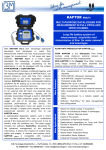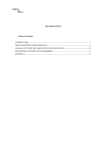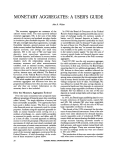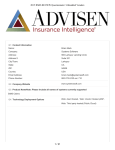Download LOGIK for London The London Green Infrastructure Toolkit User Guide
Transcript
LOGIK for London The London Green Infrastructure Toolkit User Guide Contents 1. Introduction 2. Using the toolkit: enabling content, providing data, running the toolkit 3. The climate section 4. The water section 5. The biodiversity section 6. The social return on investment section 7. Interpreting the results: 7.1- Cost-Benefit Analysis 7.2- Quantitative and qualitative benefits 8. Concluding comments Appendix.1 – Data required to run LOGIK Appendix.2 – Evaluative SROI questionnaire 1. Introduction What is LOGIK? LOGIK (the London Green Infrastructure Toolkit) is a software tool developed by a team at University College London (UCL) on behalf of the London Wildlife Trust (LWT). It is a decision-making toolkit, designed in an Excel interface, allowing the user to assess the costs and benefits of installing green infrastructure on their properties. What is green infrastructure? There are numerous definitions of green infrastructure (GI). GI generally refers to the provision of green space, or green technologies, within urban areas to enhance existing natural assets, promote environmental sustainability and alleviate effects of climate change. This can range from simple solutions such as the planting of trees and grassed areas, to more technical solutions such as green roofs. Who is LOGIK for? LOGIK is designed for the LWT, to distribute to social housing estate landlords in London. The LWT’s primary goal is to promote the installation of green spaces in London, for the benefit of human and animal populations. LOGIK is thus aimed at landlords looking to support this goal, and invest in sustainable development on their estate as an alternative to conventional upgrades and retrofits. Alongside environmental benefits, LOGIK helps landlords to see the benefits of GI that also relate to improved resident wellbeing and direct financial returns on investment. Why does LOGIK help? Why should I invest in GI? Although the benefits of installing GI are multiple, its use is not yet widespread in urban areas. Toolkits such as LOGIK have been developed in response to this, to lessen the gap between evidence surrounding the benefits of GI and the practice of investing in them. LOGIK is a calculator tool, allowing its user to assess the costs and benefits associated with installing GI on a property regarding the returns provided for different stakeholders. The toolkit assesses the benefits produced by GI in regards to the following categories: - Climate Water and drainage Biodiversity Social impacts Where possible, LOGIK evaluates these benefits in terms of financial value invested and gained, in the form of a cost-benefit analysis of outcomes. However the tool also produces quantitative evidence of benefits that cannot have a financial value placed upon them, and qualitative assessments for supplementary outcomes not evaluated within LOGIK. It must be noted that LOGIK does not provide guidance for maintenance or design specifications for GI installations. Why is LOGIK different? Other GI valuation toolkits are available to assess the benefits of GI. However, the majority of such tools focus on benefits at a large, cityscale scope. In addition, the majority of commercially available toolkits are often specific to only one benefit, or to assess a range of benefits from only one GI measure. LOGIK is different for its ability to be applied specifically to housing estates in London. The toolkit is at a much smaller and more appropriate scale therefore for use by social landlords. LOGIK also provides analysis of a wider range of benefits than alternative toolkits available, and places financial value on factors, such as social benefits, in a way that others often cannot. How do I use LOGIK? With reference to this user guide, the practice of applying LOGIK to a proposed GI implementation scheme (or one already in existence) on a social housing estate follows a number of simple steps: 1. Data collection: Certain key data requirements regarding the estate in question and GI plans are required to run LOGIK. These data requirements are outlined in Appendix 1; 2. Data input: the data collected must be input into the toolkit where specified. This is outlined in Section 2 of the user guide; 3. Running the toolkit: Outlined in Section 2 of the user guide; 4. Interpreting the results: compiling and commenting on the results produced by LOGIK to assess the overall value of GI installations on a given location. Outlined in Section 7 of the user guide. How does the user guide help? This user guide will lead the user through the steps needed in order to run LOGIK. This includes directions on how to open and run the tool initially, the data required, and how to interpret each section and the final results provided. Please note that the rationale behind the calculations and figures used within LOGIK is not provided within this user guide. For further information regarding the functions of the toolkit, refer to the Final Report by UCL to the LWT. 2. Using the toolkit LOGIK is an Excel-based spreadsheet interface. It uses ActiveX controls and Macros, so on first opening, the user must enable all content. Enabling content On Excel 2010, follow the steps: The last column of the tab allows the user to enter several trees with the same specifications at the same time. Please ensure that a number greater that 0 is entered. When the table is completed, click the Calculate button. The table to the right of the tab should update. Ensure that the Calculate button is clicked every time the inputs on the Tree Data section AND on the Project Data tab are edited or changed. 1. File>Options>Trust Center>Trust Center Settings 2. Select tab ActiveX settings and choose “Prompt me before enabling all controls with minimal restrictions” or “Enable all content”. 3. Select Tab Macro settings and choose “Enable all macros” What if one tree is close to several buildings? A single tree may be entered to this tab several times, for each building that it is close to. This will allow the Climate Section to be more accurate (a tree can have influence over several buildings). Complete the ‘Project Data’ tab Gather data about the project or proposal as required and specified in Appendix 1. This includes identification of the scope of the project, who benefits from it and who might be involved. LOGIK output Within each section, the quantitative results of the simulation will be generated and displayed. Any outputs relevant to the cost-benefit analysis are automatically transferred across. See Section 7 for further information on interpretation of results. Complete the ‘Tree Data’ tab On this tab, all trees to be added on the estate as part of the GI implementation scheme must be listed. The Species column is not compulsory, but will be used in order to complete the Biodiversity section of LOGIK. If unsure of the species proposed, leave this section blank. Please ensure that all cells within this section are filled; otherwise the line will be ignored. 3. The Climate section What is the Climate section? In this section, the impact of GI on energy consumption linked to temperature control inside the building and on levels of CO 2 released in the atmosphere is assessed. The GI considered are trees and green roofs. How do I use the climate section? Inputs: In order to run the climate section, the inputs required are: - Specification regarding trees to be installed entered in ‘Tree Data’. For this section, a tree shading two different buildings must be entered twice, with the distance and orientation related to the two buildings considered; - NB: if tree shading on two different buildings is required, the climate section of LOGIK must be run separately from the rest of the toolkit (see Section 2); - Specification regarding green roofing: automatically updated from ‘Project Data’; - The energy efficiency of the building: energy efficiency (A-G) is automatically updated from information required within ‘Project Data’ in order to estimate energy consumption. If, instead, the user knows the exact energy consumption of the buildings, this may be entered in cell F26. Outputs: The outputs of the climate section are organised in different subsections: - Reduced building energy consumption for cooling: here, the proportion of annual electricity consumption for cooling that could be saved via the proposed installation of trees and green roofing is automatically calculated. The total savings are expressed in both energy units (kWh per year) and monetary units (£ per year). - Avoided carbon emissions from building energy savings for cooling: here the reduction in CO2 emissions due to electricity consumption savings for cooling are automatically calculated. A monetary value is automatically placed upon this carbon dioxide considering the carbon trade exchange rate. - Reduced building energy consumption for heating: here the proportion of the annual gas consumption for heating that could be saved using trees and green roofing is automatically calculated. The total savings are expressed in both energy units (kWh per year) and monetary units (£ per year). - Avoided carbon emissions from building energy savings for heating: here the reduction of CO2 emissions due to the gas consumption savings for heating are automatically calculated. A monetary value is automatically placed upon this carbon dioxide considering the carbon trade exchange rate. - Total energy savings: here the calculations for cooling and heating are automatically totalled, and the proportion of energy saved with GI assessed. The results are expressed in energy units (kWh per year) and monetary units (£ per year). - Carbon stored in trees: here the annual amount of CO2 sequestered in the proposed trees is automatically calculated, and its monetary value given according the carbon trade exchange rate. 4. The Water Management section What is the Water Management section? GI can contribute to the storage and interception of rainwater and promote more natural drainage within urban environments. Sustainable urban drainage systems (SUDS), when applied in cities, provide benefits such as reducing damage to properties from surface water flooding. This section of LOGIK analyses the effect of installing GI on water, by assessing the impact of green roofs, rainwater harvesting and trees on rainwater runoff. How do I use, and interpret the results of this section? There is little required user input directly into the Water Management section of LOGIK. The majority of data will automatically update from data input into ‘Project Data’. The following sections are demonstrated within this section: (1) Green Roofs Type of Green Roof: two main types of green roofing are available within LOGIK: intensive and extensive. These will be automatically updated from selections made in ‘Project Data’; Area of Green Roof: the area of each type of green roofing to be installed automatically updates from data input in ‘Project Data’; Installation Cost: for each type of green roof proposed, an estimated installation cost is automatically calculated by LOGIK; Rainfall Retention: The estimated quantity of annual rainfall that is possible to retain within the designated amount and type of green roof proposed is automatically calculated; Savings in private stormwater infrastructure: The financial value of reducing runoff on an estate is quantified regarding savings from a reduced need to install and maintain stormwater infrastructure (e.g. drains and pipework). This is automatically calculated in relation to the rainfall retention (and therefore runoff reduction) benefits of green roofing specified. The financial benefit is estimated based on applicable case study evidence. For detailed explanation of the equations used to calculate rainfall retention and stormwater savings, refer to the methodology for LOGIK’s development found in the Final Report of UCL to LWT. (2) Trees Type and number of Trees: two main categories of trees are considered in LOGIK, deciduous and coniferous. The number of each to be installed should be specified within this section by the user, where requested; Stormwater runoff of rainfall: this is set within LOGIK as a % value of annual rainfall intercepted by each type of tree. These values are founded on case study evidence and should not be altered; Stormwater Runoff: using the % rainfall intercepted by each tree type, total annual runoff reduction (considering annual rainfall in London) is calculated automatically by LOGIK for trees proposed; Precipitation intercepted and transpired: together, these values amount to roughly the same value as ‘stormwater runoff of rainfall’, since interception and transpiration by trees are primary components resulting in overall runoff reduction. These values are founded on case study evidence for the tree type specified. No further calculations are based upon these values, and they are purely for the information of the user, and to confirm the validity of % runoff reduction values. For detailed explanation of the equations and case study data used to estimate rainfall retention of trees, refer to the methodology for LOGIK’s development found in the Final Report of UCL to LWT. (3) Rainwater Harvesting Type of roof: three types of roof can be considered for application of rainwater harvesting: conventional (no green roofing to be installed), extensive or intensive green roofs; Area of roofing: the area of each type of roof specified above, where rainwater harvesting techniques are planned to be installed, should be specified within this section by the user, where requested; Harvested water available: the quantity of water potentially available for harvesting annually (considering average London annual rainfall) from rainwater harvesting methods applied to the area of each roof type is automatically calculated; Demand met: LOGIK automatically calculates how much of the total annual water demand of estate residents could potentially be met through re-use of the water available from harvesting; Cost savings: the potential cost savings from the installation of rainwater harvesting, in relation to reduced water demand from the mains, is automatically calculated by LOGIK; Water demand and mains water costs: the two previous calculations within LOGIK are reliant on two user input requirements for the Water Management section: The annual water demand (m3) of the estate must be input by the user where specified; The main water costs (e.g. £2.00 per m3) for supply and sewerages charges must be inserted by the user where specified. For detailed explanation of the equations used to estimate rainfall harvesting potential on roofing, refer to the methodology of LOGIK’s development, found in the Final Report of UCL to LWT. 5. The Biodiversity section What is the biodiversity section? The biodiversity of a housing estate is the range of varieties of life forms present. This is measured according to two concepts: the richness and the evenness of species. Richness is the number of different species living within the environment, and evenness quantifies how equally represented different species are in the environment. These two approaches are explored as far as possible within this section of LOGIK. How to use the biodiversity section? Inputs: In order to run the biodiversity section, the user must ensure all data has been entered correctly within the ‘Tree Data’ tab, entering the exact number of trees per species. This section is also heavily reliant upon inputs within ‘Project Data’, such as total installation of green space. Outputs: The outputs of this section are organized into three different subsections: > General considerations: this section estimates the richness of estate biodiversity. This richness is assessed in terms of tree species, as the number of different tree species to be installed can be easily identified by the user. However, the richness of the fauna biodiversity cannot be assessed within LOGIK precisely. However, since it is well known that numbers of animal species living in an environment are highly correlated to total area of green space provided, the area natural habitat created by GI installations on an estate is calculated by LOGIK within this sub-section; > Biodiversity indices for trees: this sub-section represents biodiversity on an estate in relation to common biodiversity indices: the Simpson’s index and the Shannon’s index. These indices give an estimation of the evenness of biodiversity on the site. Once again, this can only be performed regarding tree species in LOGIK: The Simpson index is the probability that two trees randomly selected on the estate will belong to the same species. It results in a value between 0 (infinite diversity) and 1 (only one species is represented); The Simpson reciprocal index gives better understanding of the impact of species richness: it takes its values between 1, and the total number of species of tree. The higher the Simpson reciprocal index produced, the greater the tree biodiversity; The Shannon index calculates the uncertainty of the species of one tree randomly selected in the estate. It takes its values between 0 and log(richness). The higher the Shannon index results, the greater the tree biodiversity; The Simpson reciprocal index and the Shannon index results are both presented within LOGIK in comparison to their maximum values. > Species repartition: this sub-section represents graphically the tree species distribution, as found within the Biodiversity Section, and illustrates the concept of evenness graphically, as has been expressed by the indices. 6. The Social Return on Investment section What is a SROI? A Social Return on Investment (SROI) in embedded within LOGIK to assess the social benefits of installing GI. It is a relatively new technique, adopted and developed by the UK Cabinet office, with hundreds of accredited practitioners worldwide. The most recent Cabinet Office report was released in 2012 and used to inform the development of SROI analysis within LOGIK. Refer to Cabinet Office guidance for further detail on the SROI methodology. The SROI within LOGIK is a framework to measure and place financial value on the social outcomes of installing GI. It allows financial value to be attributed to outcomes that are non-financial in nature, but offer a valuable return for stakeholders. Why is a SROI important to LOGIK? Alternative GI valuation toolkits generally fail to quantify and assess the social benefits of installing GI. This is due to the difficulty in placing financial value on social returns to an individual (for example improved health). A SROI counters this, which is important within LOGIK, as the concerns and wellbeing of residents are at the heart of a social landlord’s motivation to install GI. By including a SROI in LOGIK the user can see the valued social benefits, and directly compare them to each other during decision-making to maximise the benefits gained. How do I use the SROI? There are two different SROIs in LOGIK, only one of which will be used at a time. The following steps should be followed: (1) Select a SROI and input data The Forecast SROI: This SROI is used before GI installations have been made on a given estate. It will be completed to predict the expected social outcomes of the project, which will occur if the installations meet their expected outcomes. > If this SROI is selected, complete the ‘Forecast SROI’ section in the ‘Project Data’ tab. The Evaluative SROI: This SROI is used after GI installations have been made on a given estate, and a given amount of time has passed (one year suggested) for social impacts to be felt by residents. It is thus used as a validation of a forecast SROI, to see true social outcomes based upon data collected after GI installations. This data should be gathered via the resident survey in Appendix 2. One survey should be distributed per household. > If this SROI is selected, complete the ‘Evaluative SROI’ section in the ‘Project Data’ tab. (2) Complete the steps of the SROI Both SROI analyses are presented in the form of an ‘Impact Map’ in the main SROI tabs, which contains 5 key steps to follow: (2.1) Complete steps 1-3: Steps 1-3 require little user input. The sections described below update automatically using relevant data from within ‘Project Data’: Stakeholders: where stakeholders are specified (landlords and residents); Outcome/ change occurring: a number of benefits expected for each stakeholder are specified and explained; Inputs: any investment made is described; Value: the value of the financial investment made is automatically updated from ‘Project Data’. Other benefits require no financial investment and should be left blank; Indicator: the method used to quantify the benefit occurring is described; Quantity: using the indicator specified, the quantity of change is automatically calculated within the SROI. For the Forecast SROI, quantities of change are best estimates founded on case study evidence. For detailed explanation of the equations used within this SROI, refer to the methodology for LOGIK’s development found in the Final Report of UCL to LWT. For the Evaluative SROI, the quantity of the change will directly input from results of the resident survey specified in ‘Project Data’; Duration: the length of time that each change will affect a stakeholder. In LOGIK, maximum values for duration are set at 5 years, after which another SROI may need conducting to re-assess social outcomes. Some benefits, such as increased property values due to GI, are considered a one-off annual return. Although these durations are set, the user may alter them if appropriate, and the SROI result will automatically update to accommodate this, up to a maximum of 40 years.; Financial proxy used: to place a financial value on the quantity of changes, proxies are used. The proxy is described here; Value of the proxy: the value of the financial proxy specified for each change. These values are founded on case study evidence and should not be changed. (2.2) Complete step 4: 3 filters are applied within this step for both SROIs, to each outcome: > Deadweight: An assessment of how much of each change would have occurred anyway without GI installations. This can be analysed via national indicators. Within LOGIK, this is only relevant regarding increased property values after GI installations, because some increase could also be due to national property value increases. Therefore within both SROIs, the average London property price increase over the year in question (specified by the user within ‘Project Data’) is used to account for this. For the evaluative SROI, deadweight for other changes is assessed using the resident survey input to ‘Project Data’, which asks participants to attribute benefits to GI installations, or not. For the forecast SROI, deadweight must be based upon best estimates of likely responses of residents. Within LOGIK, estimates for the forecast SROI are set at an assumption that 80% of the residents may report improvements in physical and mental health, social activity and knowledge as attributable to GI. This translates automatically to deadweight of 20% within the SROI. All other outcomes are assumed solely due to GI installation, and deadweight can be left blank. Values can be altered within ‘Project Data’ if seen fit by the user. > Attribution: The effect that any external influence, or project running in parallel to GI installations, could have had on outcomes is identified. Within both SROIs all attribution is set to zero. If the user knows of external factors influencing outcomes, these values may be modified within the impact map. For example, if pollutant-reduction policies were implemented locally (e.g. the congestion charge) at the same time as the GI project began, the user might assume only 30% of achieved pollutant reduction on their site was due to the GI. Therefore the user should insert an attribution of 70% in the impact map for this outcome. > Drop-off: Used to estimate how much an outcome declines every year, as its value depreciates. As recommended by the SROI guidelines, within LOGIK drop-off values for each outcome are set at 10%. The user should not change this unless more accurate values are known. (3) Interpreting the results: Step 5 Step 5 of both SROIs requires no user input. Here, the final SROI result is calculated automatically for the number of years specified. For details on the calculation methods behind the final SROI ratio, refer to the Final Report of UCL to the LWT. The final result for any SROI is presented as two ratios, either of which can be selected by the user. The first is a net present value of all outcomes in relation to total investment in the project, and the second is a present value in relation to total investment. The resulting ratio is given in pounds gained to pounds invested. Within both the evaluative and forecast SROIs, a summary output table is produced. This shows total social benefits gained (in financial proxy value) to each stakeholder, and the final SROI ratios. This output is not included within the final cost benefit analysis of LOGIK, but as a separate quantifiable output. This is because the financial value specified by a SROI is a proxy, not a direct financial return. PLEASE NOTE: The following should be considered when applying and interpreting the results of both SROIs within LOGIK: The LOGIK SROIs are simplified, down-scaled versions following the official SROI guidelines, to adapt to the scale of a housing estate; The method is highly subjective. It is reliant on best estimate user evaluation, and case study evidence. Final results should thus be interpreted with caution; Undue importance should therefore not be given to the final ratio. It should not be compared to results from alternative SROI analysis based upon different methods and case study data; Remember that financial values used are proxies, and thus do not calculate literal financial return to an investor. A resident will not, for example, definitively save money on gym membership if their physical activity levels increase after GI installations. Gym membership price is merely used to place a justified, quantifiable value on something nonfinancial in nature. 7. Interpreting the results 7.1 – The Cost Benefit Analysis (CBA) What is a CBA? A CBA is used as the primary output from LOGIK. It converts all the inputs and outputs of a project into monetary terms and provides a final value of financial profit or loss for a whole project. From this, the user can see quantitatively, and understand, the full costs and benefits of the project over the scope of a number of years. This section of LOGIK determines whether or not implementing GI is beneficial and cost effective in the long run for a given housing estate, for the factors considered within the toolkit. How do I use the LOGIK CBA? There is no direct user input required for the CBA. The CBA will automatically update using outputs from previous sections within LOGIK. The CBA has been designed to project 40 years into the future. The user can interpret the CBA by analysis of the following components: Costs: For years 0 and 1, costs are the initial investment made and annual maintenance costs respectively. Costs for years 2-40 are calculated based upon continuing annual maintenance costs, considering yearly inflation rate; Benefits: For year 0, the benefits were determined as the sum of all annual savings in energy consumption, rainwater harvesting and carbon emissions that were output as financial savings within other sections of LOGIK. Benefits for years 1-40 are the same annual cost savings calculated, but with consideration of inflation rate within the economy; Inflation Rate: consideration of inflation was necessary for energy benefits and maintenance costs. Inflation has been assumed within LOGIK to be 5% and 1% respectively. These values will likely need updating by the user over time, as they values fluctuate with economic trends; Total Benefits: the total financial benefit gained each year after implementing GI is calculated automatically here; Discount Rate and Factor: these values are used within LOGIK to calculate the present value, and consequently net present value for a 40-years period after GI installations. These values are set and should not be altered by the user; Net present value (NPV): is calculated automatically within LOGIK to show how profitable an investment in GI is expected to be over the entire 40 year period; IRR: refers to Internal Rate of Return for any GI installation project. This is a common concept within economic theory and often provided in a CBA. The IRR makes the NPV of all financial flows for the given investment £0. This value is automatically calculated within LOGIK as supplementary information for the user alongside the CBA, a way to assess the appeal of investment in the given project. How do I understand the outcome of the CBA? All computations within the CBA are automatically calculated by LOGIK using information from other sections of the toolkit. To better understand the CBA numerical output, two bar charts are also automatically produced in two scales in order to make the understanding easier for the user. The charts graphically present and summarize the final financial costs and gains for each year as a time series. These charts should aid the user in interpreting the CBA in simple terms in order to evaluate the financial cost effectiveness of implementing GI in the long run. 7.2 – Quantitative and qualitative outputs Within LOGIK not all benefits provided by GI could be given a quantifiable financial return value. Therefore alongside the CBA, supplementary results for benefits calculated within each section (but which do not have an accompanying financial return) are compiled and summarised, under the ‘Summary Table’ tab. Any additional benefits likely to be provided by the GI measures explored within LOGIK (and some which are not), but which could not even be assessed quantitatively, are also explored. Both the quantitative and qualitative benefits outlined in the ‘Summary Table’ tab are detailed below in Table 1. Quantitative outputs are automatically updated from individual sections within the rest of LOGIK, Please refer to the relevant section within this User Guide for more detail. Section Climate Quantitative Results - All results have an accompanying financial return and were used in the CBA - No quantitative results were achievable within the climate section Qualitative Assessment - GI can alleviate high temperatures in summer via cooling processes associated with vegetation, such as shading and evapotranspiration. Green roofing may also insulate a building better from solar heating - GI alleviates the effects of climate change by sequestering carbon dioxide via vegetative respiration processes - It is expected that both alleviation of over-heating and reduction in CO2 will be additional benefits associated with the installation of GI on a housing estate, but these are not explored quantitatively within LOGIK Water Management - The quantity of rainfall retained by each type of roofing on an estate is specified - Stormwater runoff reduction, relating to trees installed and the annual rainfall in London is specified - The quantity of water potentially available for re-use via harvesting from each roof type is specified - The resulting water demand that could be met on the estate in question by this harvested water is stated - The Simpson Index and Shannon Index provide quantifiable outcomes to express biodiversity within LOGIK - Green roofing doubles the life span of a conventional roof, protecting it from damage. This is an additional financial benefit of installing green roofing, as savings are made in yearly roof maintenance and not needing to replace the conventional roof after its ~20 year lifespan - SUDS solutions not included within LOGIK (e.g. rainwater gardens and grassed areas) also help alleviate runoff - These factors could not be assessed within LOGIK due to incompatibility with the small scale of the toolkit, but are assessed qualitatively to ensure the toolkit user is aware of such supplementary benefits Biodiversity - New green space on a housing estate is likely to be populated by diverse fauna (insects, birds, etc) - This was not possible to quantify within LOGIK due to a lack of case study evidence at the scale or location of the toolkit. Therefore the user is advised qualitatively of the additional biodiversity benefits that will likely occur on their estate SROI - The financial return of all social - No direct qualitative output can be made regarding the SROI but the user must outcomes is quantified by both type of take care when analysing its results (see SROI user guide) and consider the SROI within LOGIK, as present value benefits qualitatively, as well as quantitatively gained after 5 years compared to the - The resident survey used to conduct the Evaluative SROI can be interpreted initial investment made qualitatively to provide information of resident satisfaction and opinion on GI measures in place on a given estate Table.1 - Quantitative and qualitative outputs of LOGIK : more detail description of the ‘Summary Table” tab LOGIK is only provided to the user in order to identify benefits, quantitatively and qualitatively, of installing GI on a housing estate. LOGIK does not include assessment of traditional, non-GI, methods and technologies used to achieve similar aims. Such methods are briefly outlined below, divided into technologies to mitigate problems relating to overheating, and to flooding. This is for the information of the user, as a comparison to solutions provided by LOGIK regarding GI. Overheating Common solutions used to reduce summer overheating of properties are installation of insulated glazing on windows and cool roofs. > Insulated glazing: Double glazed windows decrease building energy consumption, minimising heat loss via windows in winter, and maintaining a cooler indoor temperature in summer by preventing external heat entering. Window glazing also extends the life expectancy of a building, by protecting its materials from heat impact. Due to the resulting reduction in energy consumption and extended life expectancy of the building, energy bills and maintenance costs decrease for a resident or landlord. > Cool roofs: Cool roofing is designed with a high reflectivity. Such roofs thus allow less solar energy and heat to affect a building. This results in improved human comfort within the building, but also reduced energy demands in heating and cooling in summer and winter respectively. Cool roofing does not, however, only positively impact financially, but also allows the CO2 and pollutant emissions of a building to be reduced, improving local air quality. These solutions are valuable when GI solutions cannot be installed over a large enough area to allow sufficient alleviation of overheating. Surface Water Flooding Grey infrastructure to combat flooding issues is traditionally in the form of piped drainage and water treatment systems. Such hard engineered constructions deliver clear social and economical advantages, but can have a negative or neutral impact on the environment. Conventional piped drainage costs are lesser to install than the GI Sustainable Urban Drainage Systems (SUDS) explored within LOGIK. Similarly, maintenance costs for SUDS are higher than a traditional drainage system because they are more complex technologies. Operational costs for conventional piped drainage are low in comparison, and they have a long performance lifespan. Despite this, GI solutions to flooding provide important benefits over a conventional piped drainage system. They can effectively be used to contribute to flood risk reduction by decreasing the amount and rate of rainfall runoff from an area reaching our natural watercourses and drainage systems. SUDS solutions also provide additional environmental benefits such as water quality enhancement, and amenity advantages that traditional techniques do not. 8. Concluding comments This guide has been provided alongside LOGIK in order to facilitate the use of the toolkit and to guide the user through the interface provided. LOGIK has the aim of aiding social housing landlords in gaining and assessing the information necessary to consider the installation of GI on their properties, via an assessment of the potential benefits provided. It is likely that on a given housing estate, the user will need to implement a combination of grey and green infrastructure as the most practical solution to balance the advantages and limitations of each. LOGIK is provided for the user in order to allow a more sustainable solution to developing a housing estate to be considered. It enables the most appropriate solutions to be identified for a given estate to maximise social, environmental and financial benefits. 9. Appendices Appendix 1 – Data Requirements Table Estate property Required information Number of residents Total financial investment on GI installation project (£) Number of individual properties/homes on estate Average property value on the estate (as absolute value, not rent price) (£) Overall green space increase (grass, trees, rain garden, green roofs etc together) after GI installations (m2) Number of residents able to be involved in any food garden/ allotment plot being installed Number of trees to be installed Number of deciduous trees (specify species if possible) Number of coniferous trees (specify species if possible) Mature height category – small (<10m) Mature height category – medium (>15m) Location of the trees – distance from buildings (adjacent/near) Location of the trees – orientation (N/S/E/W) Energy rating of the buildings or energy consumption per m 2 if know Level of insulation of roofs (highly insulated/insulated/not insulated) Total building ground floor/ roof area (m2) Roof area where intensive green roofs are to be applied (m2) Roof area where extensive green roofs are to be applied (m2) Total roof area where rainwater harvesting is to be applied (m2) Water demand (m3/year) Water costs (£) Data Appendix 2- Resident Survey The purpose of this survey is to assess the impact of the green infrastructure instalments made on the … estate over the past year on residents. Please answer the following questions by ticking the appropriate box and providing detail in any space given. 1. Since the green infrastructure instalment works do you believe your living environment to be more visually pleasing? Yes No 2. Over the past year has your understanding and knowledge of green infrastructure technologies and environmental sustainability increased? Yes No 3. If yes, do you believe that the green infrastructure instalments on your housing estate have contributed towards this? Yes No 4. Over the past year do you feel that your level of physical activity has improved? Yes No 5. If yes, do you believe that the green infrastructure instalments on your housing estate have contributed towards this? Yes No 6. Over the past year do you feel like you have made new connections with other community members? Yes No 7. If yes, do you believe that the green infrastructure instalments on your housing estate have contributed towards this? Yes No 8. Over the past year, do you feel that your levels of mental health (e.g. stress, anxiety) have been reduced? Yes No 9. If yes, do you believe that the green infrastructure instalments on your housing estate have contributed towards this? Yes No 10. The number of adults (18years+) and children (below 18 years) living in your home: Adults……… Children………. 11. If you wish, please provide any details regarding your above answers or any further comments you have on the green infrastructure works on your housing estate. ……………….……………….……………….……………….……………….…………………………………………….……………….… …………….……………….……………….…………….………….………….………….………….………….………….………………….





























